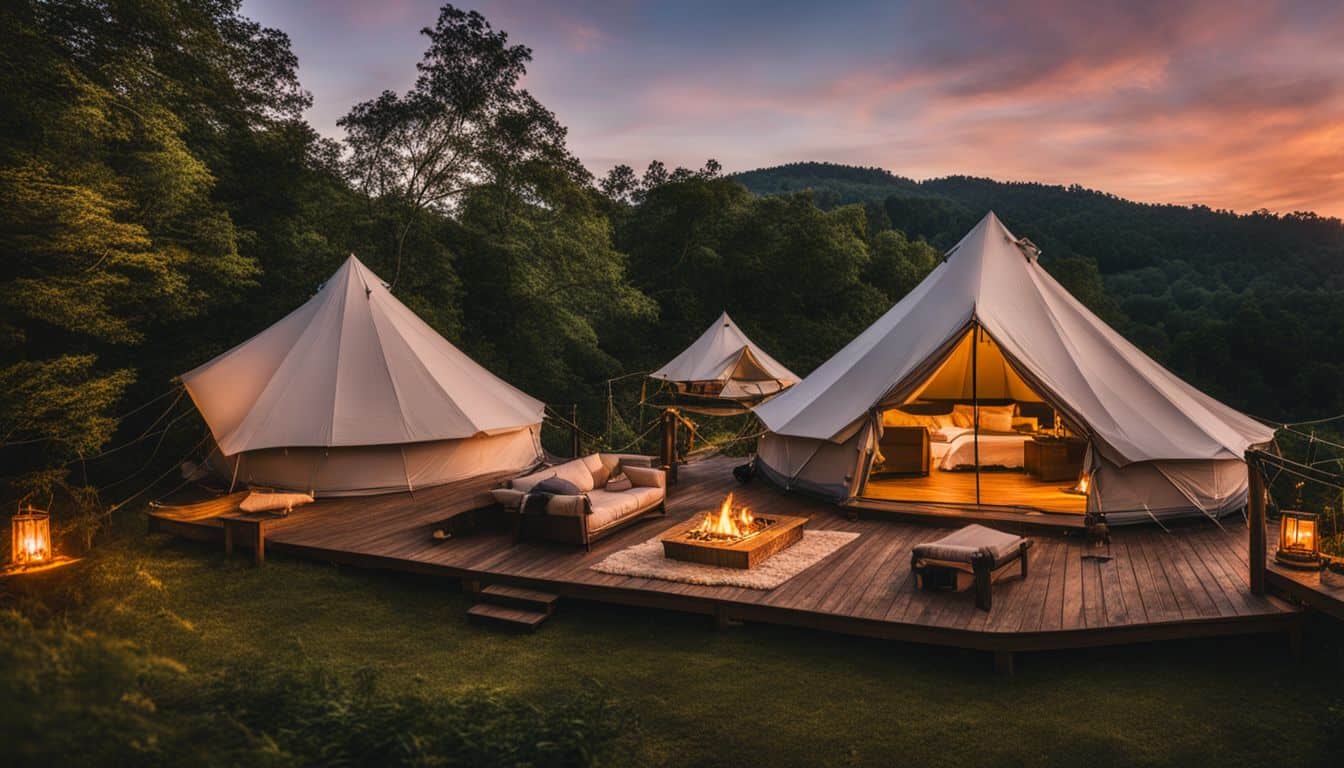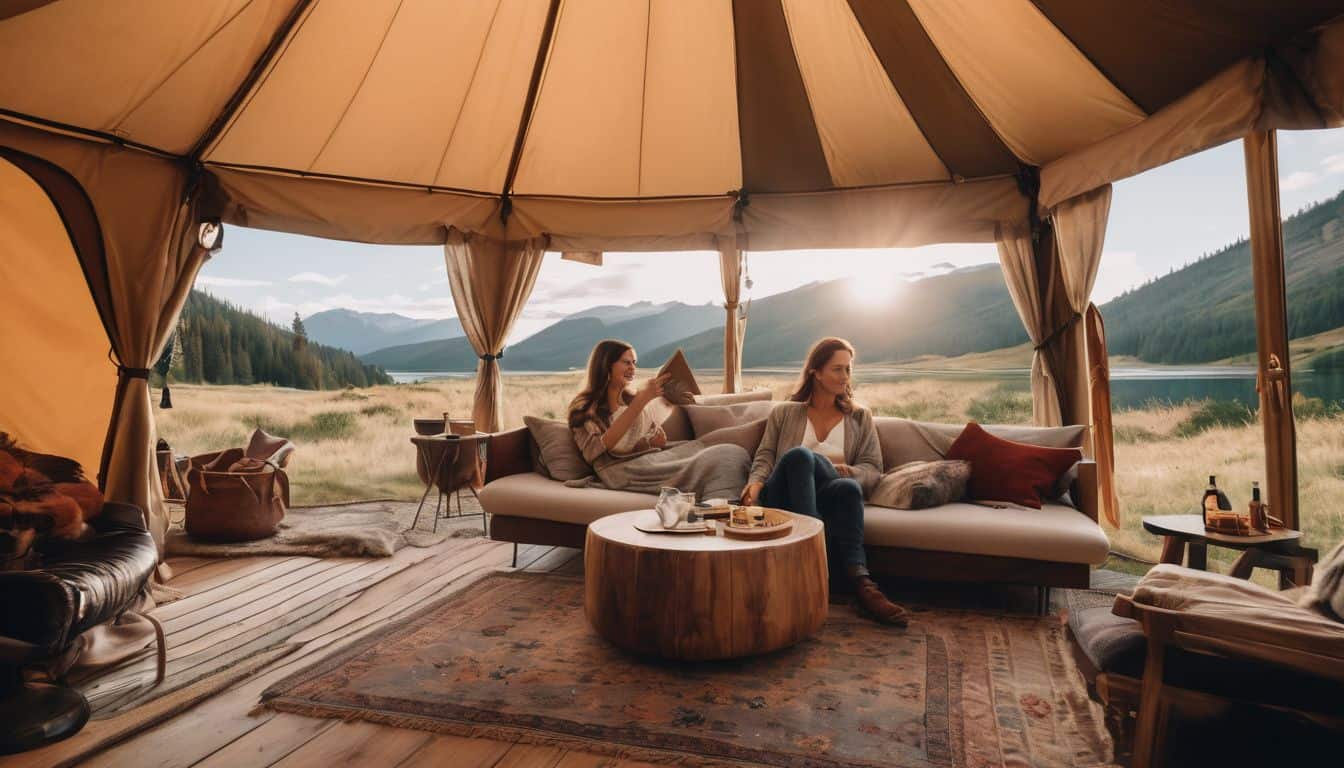Glamping, a portmanteau of “glamorous” and “camping,” has revolutionized the outdoor experience industry. This trend combines the allure of nature with the comforts of luxury accommodations, appealing to a wide range of travelers seeking unique experiences.
Glamping has come a long way since its inception. While the term itself is relatively new, the concept of luxurious outdoor accommodations dates back centuries. Today, glamping offers a perfect blend of adventure and comfort, allowing people to enjoy nature without sacrificing modern amenities.
The Growing Popularity of Glamping
Recent statistics show a significant surge in glamping’s popularity. According to a KOA report, 34% of new campers chose glamping in 2023, highlighting a growing trend towards more comfortable outdoor experiences. This rise can be attributed to several factors, including a desire for nature experiences without sacrificing comfort and an appeal to non-traditional campers and urban dwellers.
The COVID-19 pandemic has also contributed to this trend, driving people to seek safe, socially distant vacation options. Glamping offers a perfect solution, allowing people to enjoy the outdoors while maintaining luxury and privacy. This trend is expected to continue, with many hospitality companies investing in glamping facilities to meet the growing demand.

Types of Glamping Accommodations
Glamping accommodations range from refurbished Airstream trailers to Mongolian yurts and even Scandinavian-style Lushna cabins. These unique structures can be found in various settings, from traditional campgrounds to private homesteads and city-adjacent retreats, offering glamping year-round options for enthusiasts.
The diversity of accommodations caters to different preferences and budgets. For instance, luxury treehouses offer a childhood dream come true with adult comforts, while geodesic domes provide a futuristic camping experience with panoramic views. Some glamping sites even offer unique options like converted railway carriages or floating cabins, pushing the boundaries of traditional camping accommodations.
| Glamping | Traditional Camping |
|---|---|
| Luxury accommodations often include comfortable beds, fine linens, and sometimes even climate control. | Basic shelter, usually a tent, with sleeping bags and potentially uncomfortable sleeping conditions. |
| Amenities mirror those of a hotel, with private bathrooms, often equipped with high-quality toiletries. | Public restrooms or no facilities at all, requiring a back-to-basics approach to personal hygiene. |
| Meals can range from gourmet dining options to personal chefs, emphasizing convenience and indulgence. | Self-prepared food, often cooked over a fire or portable stove, embracing the do-it-yourself ethic. |
| Sites are typically pre-set and may include decks, hot tubs, and fire pits, maximizing comfort. | Set up and take down of equipment required, with campers often needing to forage for firewood and resources. |
| Activities may include guided tours, wellness retreats, and adventure sports, with an emphasis on curated experiences. | Self-guided activities that focus on exploration and personal discovery within the natural environment. |
| Glamping taps into eco-friendly practices, with many sites using sustainable materials and renewable energy sources. | Traditional camping encourages a leave-no-trace ethic, though its environmental impact varies greatly depending on the camper’s behavior. |
| Accessibility is a key feature, offering those with limited mobility or no camping skills the chance to enjoy the outdoors. | Often requires a certain level of physical ability and outdoor survival skills, potentially limiting who can participate. |
| Bookings and customer service are streamlined through digital interfaces, offering ease and efficiency. | Planning is more hands-on, with campers managing their own reservations and needing to be self-sufficient on-site. |
The Glamping Experience
The glamping luxury in the wilderness experience often includes amenities like luxurious bedding, climate control, private bathrooms, and gourmet dining options. Activities may range from outdoor adventures like hiking and horseback riding to wellness programs and cultural experiences.
Many glamping sites also offer opportunities for “digital detox,” balancing modern comforts with nature immersion. The seamless integration of luxury and nature is the key to a successful glamping experience. For example, some sites offer outdoor spa treatments, allowing guests to enjoy massages while listening to the sounds of nature. Others provide stargazing experiences with high-powered telescopes, combining education with the awe-inspiring beauty of the night sky.
The Business of Glamping
The glamping industry caters to a diverse audience, from urban professionals seeking quick escapes to families looking for comfortable outdoor experiences. Pricing varies widely, often comparable to upscale hotels but offering a unique value proposition. Companies like Eastwind Hotels are strategically expanding, carefully selecting locations to meet the growing demand.
The business model of glamping often involves partnerships between landowners and hospitality experts, creating unique experiences that capitalize on natural beauty and luxury service. Many glamping businesses also focus on sustainability, using eco-friendly practices as a selling point to environmentally conscious travelers.
The Impact of Hybrid Work on Glamping
The rise of remote work has influenced glamping trends, with many sites adapting to accommodate “workcations.” This includes providing reliable Wi-Fi and workspace options while maintaining the essence of a nature retreat. Some glamping sites now offer dedicated co-working spaces with high-speed internet, allowing guests to balance work responsibilities with outdoor experiences. This trend has led to longer average stays at glamping sites, with some guests opting for week-long or even month-long retreats. The ability to work from anywhere has opened up new possibilities for the glamping industry, blurring the lines between vacation and everyday life in exciting ways.

Environmental and Sustainability Considerations
Many glamping sites prioritize eco-friendly practices and sustainability, minimizing environmental impact and educating guests on conservation efforts. This commitment goes beyond basic recycling programs. Many sites use solar power, implement water conservation systems, and source local, organic food for their dining options. Some glamping locations even participate in reforestation projects or wildlife conservation efforts, allowing guests to contribute to these initiatives during their stay.
Educational programs are often integrated into the glamping experience, teaching visitors about local ecosystems, sustainable living practices, and the importance of preserving natural habitats. This focus on sustainability not only appeals to eco-conscious travelers but also helps preserve the pristine environments that make glamping destinations so attractive.
The Future of Glamping
As the industry evolves, we can expect to see emerging trends such as smart tents and even underwater or treetop accommodations. The challenge will be maintaining authenticity while scaling to meet demand. Technological integration is likely to play a significant role, with features like app-controlled climate systems and virtual reality experiences enhancing the glamping experience.
We may see more themed glamping sites offering immersive experiences based on historical periods or fantasy worlds. The industry is also likely to expand into new frontiers, with some companies already exploring concepts like space glamping. As glamping continues to grow, maintaining the balance between luxury and connection to nature will be crucial to preserving the essence of the experience.
Conclusion
For those interested in trying glamping, it’s essential to be prepared. Check out this comprehensive glamping checklist to ensure you have everything you need for your luxurious outdoor adventure. This list covers everything from essential clothing and gear to luxury items that can elevate your glamping experience. Proper preparation can make the difference between a good trip and an unforgettable one.
And if you’re concerned about costs, don’t worry – there are plenty of options for glamping on a budget that still offer a fantastic experience. Budget-friendly glamping might involve choosing off-peak seasons, opting for less elaborate accommodations, or even creating a DIY glamping setup at a regular campsite.
With some creativity and planning, you can enjoy the luxury of glamping without breaking the bank. Remember, the essence of glamping is about connecting with nature in comfort, and that can be achieved at various price points.
Glamping represents a significant shift in how people experience the outdoors, blending luxury with nature in innovative ways. As this trend continues to grow, it has the potential to reshape the future of outdoor tourism and accommodation.

Leave a Reply